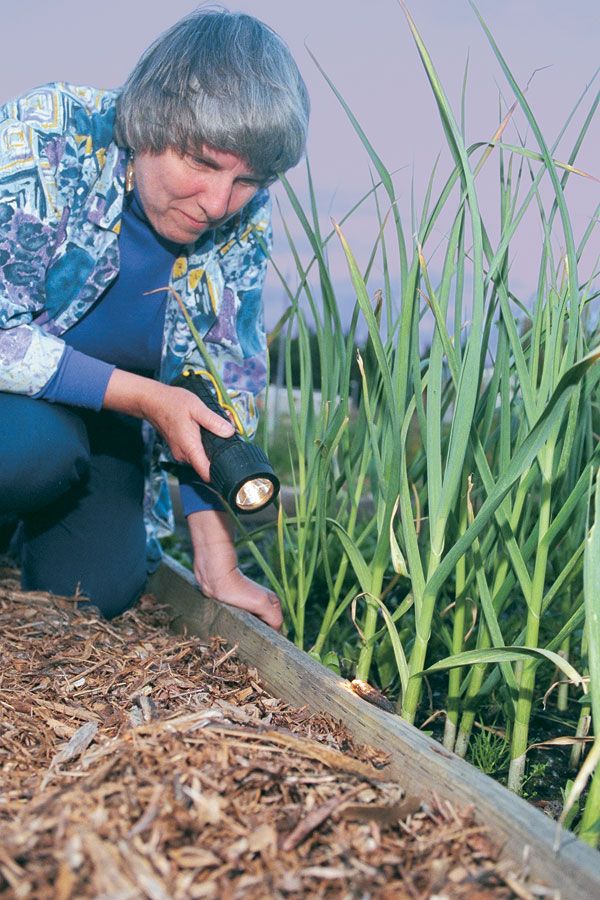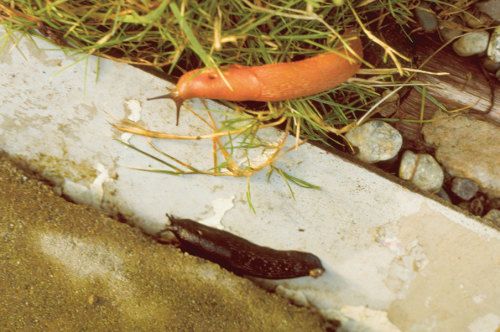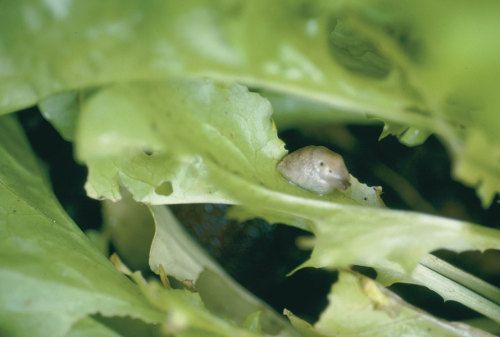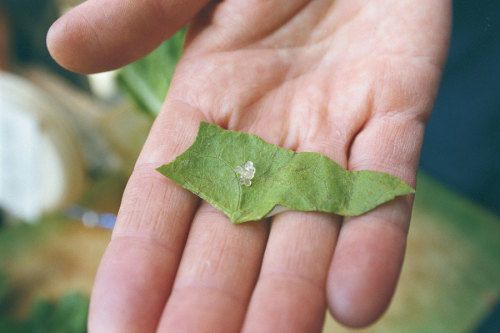
by Sharon J. Collman
February 1997
from issue #7
Slug. Ugh! A natural reaction. But I no longer respond that way. My view began to change about 10 years ago as I researched and photographed slugs for a gardener-training program. I found myself belly-down on the ground, camera in hand, watching a slug close in on a meal. Glistening, sleek, and muscular, the slug made its way to the plant in a straight and sure manner. This loathed pest became for me a creature of intelligence, even beauty. No doubt most people will continue to view slugs as disgusting. Fair enough. In my garden in Seattle, slugs aren’t the most welcome critters, either. But they are worthy of some respect. And knowing their habits helps me protect my plants.
Slimy but resourceful
No question, slugs are wily creatures. Relatives of aquatic oysters and clams, they can squeeze into the tiniest of places and burrow several feet into the soil. They can climb trees. They can ride a mucus pontoon over barriers of salt or abrasives. They can store water to get them through a dry spell. They can do trigonometry.
Slugs leave calling cards. First, you need to know whether slugs have breached your garden gate. Aside from the telltale slime trails, slugs have distinctive table manners. They lick their prey with their radula, a tongue equipped with thousands of tiny teeth. The rasping radula usually puts ragged, ratty holes in leaves and fruit, although with tough plant tissue, the holes may be cleaner (photo, above). Slugs also expel small squiggles of excrement. Most likely, you will simply see the slugs if you look in your garden in the early morning or evening darkness.
Slugs come in many shapes and sizes, with varying life cycles, dining habits, and hiding places. You must be observant to get a leg up on slugs. You might lure large brown slugs with bait and not notice that it’s the little gray slugs actually doing the most damage.
Only a few types of slugs are major garden pests. Chief among them are the European black slug and the milky slug. Though called a black slug, this type also can be brown or orange-brown. The European black slugs are about 6 in. long, with skin furrows. They lay eggs in late summer and fall. The milky slug is usually 2 in. to 3 in. long, varying in color from white to mottled dark gray. This type lays eggs from early summer through fall and often hides on the underside of plant leaves. What these slugs lack in size, they make up for in numbers and appetite, eating their weight in plants each night.
You might need to stoop to conquer
The first step in controlling slugs is liquidating their lairs—the boards, bricks, rocks, pots, plants, compost, tall grass, firewood, and piled trash that clutter gardens. This will never end your problem with slugs, but will at least make your garden more attractive to people and less so to slugs.
Timing is everything. Slugs usually slog into action in the cool, moist evening. Gardeners unwittingly help them by watering in the late afternoon and evening. This tactic might conserve water by avoiding evaporation in the hotter part of the day, but watering in the early morning also saves water and allows the plants and soil to dry during the day and make them less hospitable to slugs.
Out of sight doesn’t mean slugs are out of town. When the weather turns dry and hot, most slugs head for deep shade and shelter. Slugs can burrow into the soil to stay moist. They can go into the summer equivalent of hibernation, called estivation, to wait for wet weather. When you go into the garden on nice days and see the damage inflicted, you will be tempted to spread slug bait right away. But it won’t be effective. You will need to wait until the slugs resurface.
A pinch of salt, a splash of ammonia. Who among us has not salted a slug out of pure spite or irresistible curiosity? Salt does kill slugs. The salt sucks the water out of the slug, drying it to death. In defense, the slug goes into super slime production trying to rid itself of the salt. Sometimes it succeeds, and you may not be there when the slug slinks off to lick again another day. Salt also can cause collateral damage, harming both soil and plants. As for salt-impregnated barriers, they have not produced good results in my garden.
Some people swear by ammonia. I’ve used a solution of one part ammonia and four parts water. At this strength, the solution won’t damage the soil or plants. But when I tested this method by squirting the solution on three large slugs, I found I didn’t have the stomach for the 20 minutes of writhing as the slugs tried to produce enough mucus to give the ammonia the slip. And after all that, the slugs survived. So I don’t use this method anymore.
Simple traps with simple baits. Baiting and trapping will be the bulwark of any successful defense against slugs. Traps for slugs can be as simple as boards placed on the ground, pots placed upside down on the shady side of a plant, or overturned cantaloupe or grapefruit rinds. Check your traps in the morning to catch the resting slugs. Even plants themselves can be used to attract slugs to an area. Slugs love marigolds and zinnias and you can plant one or two in strategic locations as a distraction. I’ve even found that tossing a few blossoms on the ground narrows the scope of my slug patrols.
Lidded plastic containers with openings cut in the side make good traps. Bait them with potato slices, lettuce, or peas, then snap on the lid. This keeps the bait dry and protects slugs so they don’t want to leave. They can be removed in the morning.
Beer brings slugs running. A container with some beer will quickly turn into a slug bath. The beer anesthetizes them so they cannot escape. And then they drown. The container should be checked every day or two to clear it of slugs and make room for more. If the container is too full of slugs, the next slugs in won’t drown, and they may not come at all if the bar is too foul. The beer should be changed regularly, too. These simple traps also provide a good barometer of slug activity in your garden. Make sure the lip of the trap is at least 1 in. above the ground so that beneficial beetles don’t accidentally fall in.
Use pesticides carefully. Baits laced with pesticides, such as mesurol or metaldehyde, come in many brands and different strengths. Most people use too much bait in the wrong places. I have seen bait sprinkled on garden vegetables, which is wasteful and dangerous. Since bait draws slugs to it, there is no reason to scatter it by the handful over the garden.
Less toxic baits paralyze the slug, which then slowly dries out during the day and dies. However, if it is a cool, humid day, the slug will recover and learn to avoid baits. The higher the percentage of active ingredient, the more likely it is to kill slugs directly and pose more risk to pets and other animals. Use extreme caution with pesticides. Follow the directions and warnings.
By hand or by tong. You can remove slugs by hand if you aren’t too squeamish. Or you can use tongs. This will reduce their immediate impact on plants, and may cut back on the number of eggs laid if it is done before the egg-laying season for that species. But many slugs will be too small or well hidden to find. Some become almost invisible, since they look much like rolled, dead leaves.
Death and disposal. I try to keep slugs away from desirable garden plants and minimize their damage, not eradicate them. Slugs play a crucial role in the recycling process of natural habitats, helping to distribute seeds and spores. They also are part of the food chain, serving as meals for birds, moles, skunks, snakes, frogs, and other critters.
I don’t think it’s going too far to concern myself with the manner of killing slugs. I try to do it humanely. I put them in a container, then cap and bag the container and put it in the freezer for a hour or so until the slugs are frozen hard. Then they can be tossed in the compost and be really useful. The simplest method of dispatching slugs is chopping them with your shovel or trowel whenever you see them. One centered slice does the trick, and they don’t grow new heads or tails.























Comments
Log in or create an account to post a comment.
Sign up Log in